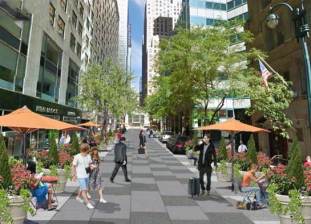Rezoning to Encourage Street Life on Brooklyn’s Fourth Avenue

When the Department of City Planning put forward its rezoning of Park Slope in 2003, one of the earliest of the now 111 rezonings under Mayor Bloomberg and City Planning Commissioner Amanda Burden, it was intended to help turn Fourth Avenue into “a grand boulevard of the 21st Century.”
The sought-after residential development has started to take place, but at street level, there’s been widespread disappointment with the results. Instead of providing a healthy pedestrian realm, the ground floor of many new developments has been taken up by ventilation equipment and even a surface parking lot.
In response, the Department of City Planning has put forward a new set of rules intended to ensure that as Fourth Avenue develops further, it does so in a way that invites people to walk along the street.
At least half of the ground floor frontage of each new building along Fourth would be required to be retail, and parking wouldn’t be allowed anywhere along the ground floor street frontage. Requirements for a certain amount of glass storefronts would provide opportunities for window-shopping, while strict restrictions on curb cuts across Fourth Avenue sidewalks will give pedestrians more space and comfort.
With the endorsements of local Council Members Brad Lander, Stephen Levin and Sara González, the plan is likely to move relatively smoothly through the land use review process over the next few months.
The underlying zoning, including bulk, use, and parking requirements, will remain the same along Fourth. However, many of the worst offenders of the last development cycle would not be up to code under the new regulations.
The “Le Bleu” hotel, for example, includes a curb cut to a surface parking lot in front of the building, two would-be violations of the new zoning rules. Behind the parking lot is a lobby without any retail, another violation. If that project had been built under the proposed rules, the hotel could still have parking, but it would have to be structured parking, at least thirty feet back from the street or underground and accessed from a side street rather than Fourth.
It will be interesting to see how developers respond to the tighter restrictions on where parking can be placed. Building underground parking on Fourth is even more expensive than usual due to the subway tunnel that runs under the street, so it’s not unlikely that, on the margin, barring parking from part of the ground floor will result in less total parking being built along the street.
While parking requirements along Fourth generally require a parking space for 40 percent of the dwelling units, much of the parking built along the street was a result of developers’ profit motive. At the Novo, for example, the developer built 60 spaces when only 45 were required by zoning. At the Crest, a DCP spokesperson said, the developer was eligible to have parking requirements waived entirely. In buildings like those, neither of which engages the sidewalk, making it slightly more difficult to build parking could mean the developer would choose to build less parking altogether.
When DCP originally rezoned Park Slope, a department spokesperson told Streetsblog in 2008, it opted against retail requirements on the grounds that in a less-established commercial area, such requirements might inhibit development altogether or result in empty storefronts. That they are ready to put those requirements in place on Fourth — similar transparency rules are in effect on 125th Street and the St. George area of Staten Island, according to DCP — suggests that even in a downturn, the real estate market in that rapidly gentrifying section of Brooklyn is strong.
